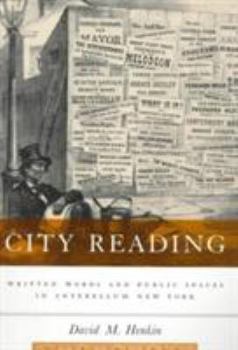City Reading: Written Words and Public Spaces in Antebellum New York
Select Format
Select Condition 
Book Overview
Cultural historian David Henkin explores the influential but little-noticed role played by reading in New York City's public life between 1825 and 1865. From the opening of the Erie Canal to the end of the Civil War, New York became a metropolis, and demographic, economic, and physical changes erased the old markers of continuity and order. As New York became a crowded city of strangers, everyday encounters with impersonal signs, papers, and bank...
Format:Paperback
Language:English
ISBN:0231107455
ISBN13:9780231107457
Release Date:December 1998
Publisher:Columbia University Press
Length:224 Pages
Weight:0.85 lbs.
Dimensions:0.6" x 6.0" x 9.0"
Customer Reviews
0 rating





